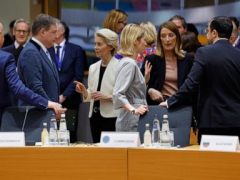FRANKFURT, Germany — With U.S. support for Ukraine in doubt, Kyiv’s European allies are weighing whether to seize $300 billion in frozen Russian assets and use the money to compensate Ukraine, support its military and help rebuild shattered homes and towns.
For now, the assets are still on ice, with opponents of seizure warning that the move could violate international law and destabilize financial markets.
Here are key things to know about the debate surrounding the Kremlin assets that were frozen shortly after Russia’s full-scale invasion in early 2022:
Originally, the money was in short-term government bonds held as reserves for the Russian central bank. By now, most of the bonds have have matured and turned into cash piling up in custodian banks. Some 210 billion euros are in European Union member states, with the biggest chunk, some 183 billion euros, at Euroclear, a Belgian clearinghouse for financial transactions. Other amounts are at financial institutions in Great Britain, Japan, France, Canada, Switzerland, Australia and Singapore.
So far, the Group of Seven democracies have used the interest on the frozen cash to fund $50 billion in upfront assistance to Ukraine by borrowing against future interest income. That solution avoids legal and financial complications associated with outright confiscating the money and giving it it to Ukraine.
Some of Ukraine’s friends — Poland, the United Kingdom and the Baltic states Lithuania, Latvia and Estonia — want to do more by taking the principal as well, given the enormous damage Russia has done. The World Bank estimates that reconstructing Ukraine will cost $524 billion over 10 years, already more than the total of the Russian assets. If one or more Western governments resists seizing the assets, the others that want to could still go ahead.
Meanwhile, Ukraine’s allies in Europe are contemplating stepping up their financial aid in the wake of statements by U.S. President Donald Trump that Europe must take care of its own security. Several of those allies — France and Belgium, for instance — are already saddled with troublesome debt levels above 100% of gross domestic product.
European leaders say seizing the assets now would mean they couldn’t be used as a bargaining chip in any peace deal or to help enforce a ceasefire.
French Finance Minister Eric Lombard said Tuesday that it was against international law to seize assets in central banks. If Russian assets were seized without legal grounds, “it could pose a risk to European financial stability,” he said.
“I advocate great caution when it comes to those frozen assets,” Belgian Prime Minister Bart De Wever said at a March 6 EU summit. “At the moment, that is actually a chicken that also lays golden eggs. Those windfall profits are going to Ukraine.”
Opponents of seizure also fear that countries and investors would hesitate to use European financial institutions if they are afraid assets could be seized, undermining the euro’s role as an international currency for state reserves.
More specifically, government




